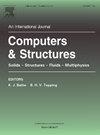基于欧拉-拉格朗日耦合方法的混凝土磨损性能数值研究
IF 4.8
2区 工程技术
Q1 COMPUTER SCIENCE, INTERDISCIPLINARY APPLICATIONS
引用次数: 0
摘要
本文对水工建筑物混凝土的磨损性能进行了数值研究,并考虑了混凝土的结构特性和各种水力条件。混凝土的三维中尺度模型由骨料、砂浆和界面过渡区组成,使用内部Python 2代码和商业有限元软件Abaqus 2021开发。采用欧拉-拉格朗日耦合方法模拟了水动力场与混凝土结构之间复杂的相互作用,重点研究了磨损、材料损失和能量响应作为控制水力参数(流速和泥沙浓度)的函数。结果表明,水流速度和泥沙浓度对混凝土的磨损性能影响较大,且与水流作用在混凝土结构上的动能密切相关。本文章由计算机程序翻译,如有差异,请以英文原文为准。
Numerical investigations of the abrasion behavior of concrete based on a coupled Eulerian–Lagrangian approach
This paper presents numerical investigations of the abrasion behavior of concrete for hydraulic structures considering concrete structural characteristics as well as various hydraulic conditions. Three-dimensional mesoscale models of concrete composed of aggregates, mortar, and interfacial transition zones are developed using in-house Python 2 codes and the commercial finite-element software Abaqus 2021. The coupled Eulerian–Lagrangian approach is employed to simulate the complex interaction effects between the hydrodynamic field and the concrete structure with a focus on abrasion material loss and energy response as functions of the governing hydraulic parameters (flow velocity and sediment concentration). The results indicate that the concrete abrasion behavior is greatly influenced by the flow velocity and sediment concentration, which are highly associated with the kinetic energy in the flow exerted on the concrete structure.
求助全文
通过发布文献求助,成功后即可免费获取论文全文。
去求助
来源期刊

Computers & Structures
工程技术-工程:土木
CiteScore
8.80
自引率
6.40%
发文量
122
审稿时长
33 days
期刊介绍:
Computers & Structures publishes advances in the development and use of computational methods for the solution of problems in engineering and the sciences. The range of appropriate contributions is wide, and includes papers on establishing appropriate mathematical models and their numerical solution in all areas of mechanics. The journal also includes articles that present a substantial review of a field in the topics of the journal.
 求助内容:
求助内容: 应助结果提醒方式:
应助结果提醒方式:


